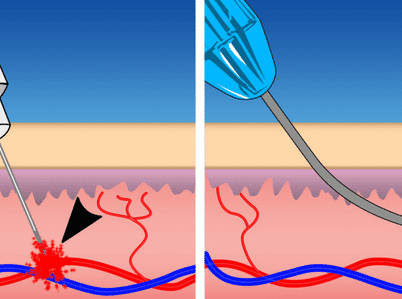Injections with sharp needles can easily puncture blood vessels and form hematomas, so to avoid such risks, blunt needles were created; so, is this the only difference between blunt and sharp needles used for micropigmentation injections?
Advantages and disadvantages of sharp needles
The advantages of sharp needles
- Avariety of injection materials, the original is sharp needles, no need to replace the needle, you can use, easy to operate, low cost;
- Flexible injection technique, a variety of techniques can be used, flexible in multiple planes and multiple injection points for free switching and fine-tuning;
- The sharp needle is finer, if used properly, the level is accurate, resulting in less tissue damage.
Disadvantages of sharp needles
- Too sharp, there is a risk of piercing the blood vessels;
- The length is usually short, sometimes it is difficult to inject evenly when injecting a large area;
- More needle points, each needle point has the risk of damage to small blood vessels, may cause surface bruising;
- New hand-held needle technique is not stable, more likely to damage the surrounding blood vessels or eyes and other sensitive organs.
Advantages and disadvantages of blunt needles
Advantages of blunt needles
- Relatively simple to control the injection level during operation;
- No sharp edge, strong elasticity, in the subcutaneous and periosteal and other loose tissue penetration, the level is extremely accurate, not easy to pierce into the muscle, will not directly pierce the blood vessels and nerves, not to mention directly into the blood vessels, if properly applied, the amount of bleeding and swelling can be reduced;
- Compared with sharp needles, the length is longer than 5cm, or even more than 10cm, and it can be used to fan and cross-fill large areas such as forehead, with fewer needle holes and easier to lay evenly;
- The needle can be inserted in a more hidden area to reach a more distant injection location.
Disadvantages of blunt needle
- It is not possible to perform flesh and skin injection;
- Blunt needle forcibly break through the formation of the surrounding tissue tear, the pain is strong, and may pull off the surrounding blood vessels, may also cause nerve endings fiber tear injury;
- The poor quality of blunt needles around the needle hole is rough, in the puncture there is a possibility of scratching the blood vessels;
- Many people think that blunt needles are safe, so they are more careless in the operation process, but ignore the pursuit of technical level, incorrect level mastery and brute force operation, which further increases the risk of operation;
- The inner diameter is much thicker than the sharp needle, pushing the injection more smoothly, under the same operating pressure, the injection volume per unit time is several times that of the sharp needle, if improperly operated, it is easy to inject too much in a certain local, forming tension compression, further inducing tissue edema, edema can further increase the compression, so the process continues, if the injection site in the tip of the nose and other parts of poor blood circulation, easy to cause compression of vascular embolism;
- The outer diameter is mostly thicker than the sharp needle, the point of entry requires additional injection of a small amount of anesthetic using a fine sharp needle, to open the hole with a thick sharp needle, otherwise the patient pain is unbearable, the operation steps are more complicated than the sharp needle.
Conclusion
There is no absolute difference between sharp and blunt needles, it depends on the skill of the user, so there is no need to forcibly distinguish between superior and inferior. Both needles are common materials for injections, and it is common to use a combination of both, which is related to the doctor’s injection skills, and not a single one which has the advantage or disadvantage.








